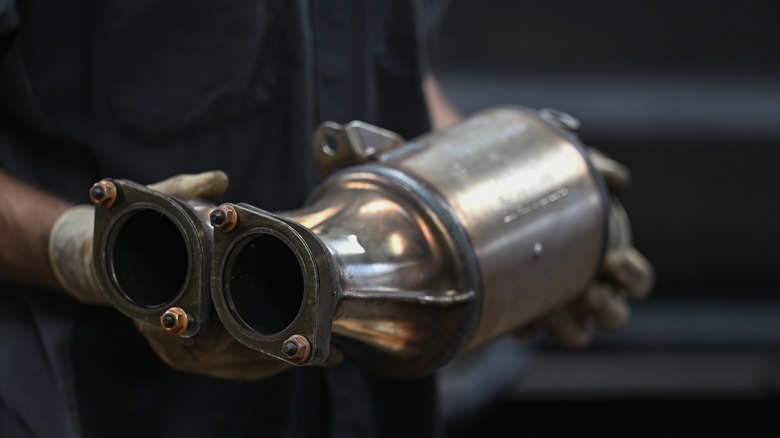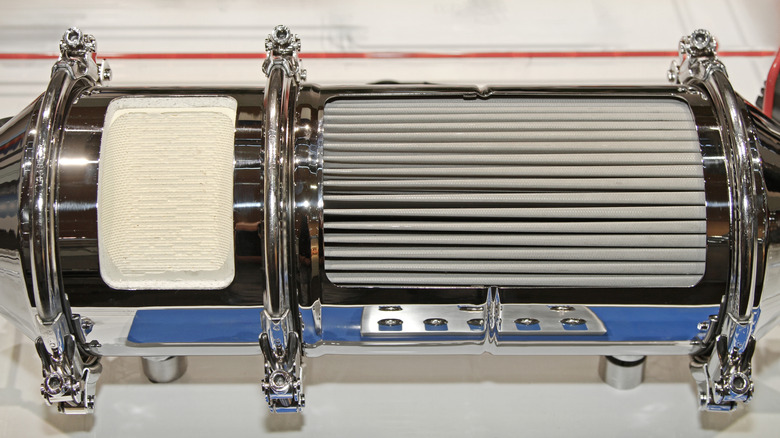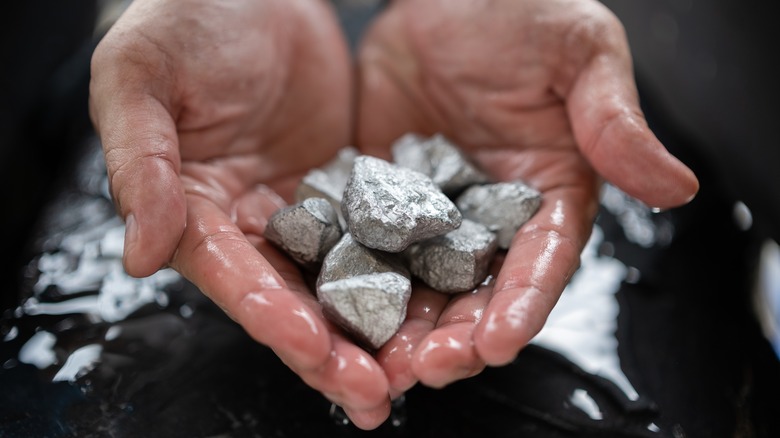How Much Platinum Is Inside A Car's Catalytic Converter?
Platinum, a metal that helps craft aesthetically pleasing jewelry, also finds use in a car's exhaust for entirely non-aesthetic reasons. The catalytic converter is required on nearly every car to remove harmful gases, such as nitrogen oxide and carbon monoxide, from your exhaust. Platinum and other heavy metals such as palladium and rhodium in the catalytic converter act a catalyst in detoxifying these gases.
However, the presence of such precious metals and catalytic converters' easy accessibility makes converters a sought-after target for thieves known as "cutters." Catalytic converter theft witnessed an exponential rise during the pandemic, peaking in 2022, when State Farm alone saw 45,000 claims for stolen converters. Cutters often sell the stolen converters to scrap recyclers, who then extract the pure platinum and palladium.
So how much platinum and palladium does your catalytic converter contain? Also, why exactly does the mostly inert platinum find its use in a catalytic converter?
Amount of platinum, palladium, and rhodium in a catalytic converter
The actual amount of these precious metals varies with models and manufacturers. Unsurprisingly, larger vehicles produce more exhaust gases (with different colors of smoke that mean different things for your car). Therefore, bigger cars and trucks need bulkier converters with more precious-metal content. Catalytic converters typically hold around 0.1 to 0.25 ounces of platinum, 0.07 to 0.25 ounces of palladium, and 0.04 to 0.07 ounces of rhodium.
The major reason why catalytic converter theft skyrocketed after the pandemic was the sudden price rise of the catalyst, especially platinum and palladium. During their peak, platinum sold for $1,289 per ounce and palladium sold for $3,307 per ounce, making a typical catalytic converter worth at least $128 of platinum and $231 of palladium. With metal prices settling since the pandemic, a typical catalytic converter now contains upward of $90 worth of platinum and $68 worth of palladium. The massive drop in prices and government efforts to end catalytic converter theft have been a key reason they've declined in recent times.
The role of platinum in a catalytic converter
Most modern cars use three-way converters that can treat nitrogen oxides, carbon monoxide and hydrocarbons. They perform the complex task of facilitating two simultaneous reactions, reducing the nitrogen oxides into nitrogen and oxygen, and oxidizing the hydrocarbons and carbon monoxide into carbon dioxide and water vapor. Platinum plays a key role in both these reactions, behaving as the common catalyst. The platinum and rhodium catalyst helps in the reduction reaction, while the platinum and palladium mixture facilitates the oxidation reaction.
While numerous other metals such as copper, nickel, manganese, cerium, and iron can all behave as catalysts for the these reactions, they often lack the stability and heat tolerance needed to withstand the high temperatures and elemental exposure in a car's exhaust. As a result, metals like platinum, palladium, and rhodium become the perfect fit for catalytic converters, helping reduce harmful exhausts that can have detrimental environmental effects such as acid rain and formation of ground-level ozone.


